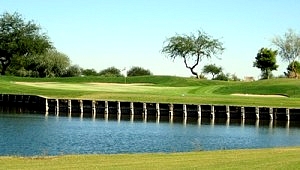The Buzz: The idea of this project was to create a course that would contrast that of the Adobe Course, built 51 years earlier, but fit with its surrounds just like its big sister at the Arizona Biltmore Resort. Architect Bill Johnston accomplished that with a design that has been alternately described as “wild, fresh, enjoyable, unconventional and a bit quirky.” Unlike the classic, parkland design of Adobe, the Links Course presents rolling fairways, desert ravines, scenic elevation drops, five lakes and deep bunkers set close to the greens. Those aren’t characteristics you might expect to find on a course in the heart of the fifth largest city in the United States, but it is part of what makes the Biltmore property the “Jewel of the Desert.”
Johnston’s design is a combination of desert golf mixed with more traditional landscape with grass running from tees to greens, but few rugged transition areas and plenty of variety built in. No two holes are alike and each day they seem to play different, placing a premium on strategy and shot-making with accuracy on a course with challenging fairways and large, undulating greens, where avoiding three-putts is at a premium. Although it plays nearly 200 yards shorter from the tips than Adobe, many golfers consider Links to be the harder of the two.
The par-71 course has three sets of tees at 6,300, 5,726 and 4,747 yards and from the back tee is rated at 69.5 with a slope of 125. It wraps around the outer edges of the 39-acre property and is tucked under Piestewa Peak with Camelback Mountain in the distance, both which provide picturesque backdrops for various holes. Johnston built some fun, in the form of risk-reward holes, into the layout, including three par-5 holes that all are reachable in two shots. It might best be described as “enjoyably quirky,” with some very sharp doglegs, including one on a short par-3 where you can’t see the green from the tee, and surprises waiting around the bends.
The signature hole is the 15th, a par 3 with a teeing area at the highest point on the property. It plays at 183 yards from the tips, with a drop of 75 feet from tee to a bunkered green, and offers excellent views of the Phoenix metro skyline and distant mountains. Another scenic viewpoint awaits at the tee on 17, which is the longest par 4 on the course at 451 yards.
A well-adorned clubhouse serves both courses and includes the Adobe Restaurant, which prepares traditional southwest cuisine that is served inside or on a veranda that overlooks an 18-hole putting green. Arizona Biltmore, created by the Wrigley chewing gum family, might be the most famous resort in the state. It offers uncommon amenities and a stately hotel inspired by Frank Lloyd Wright, which has hosted many U.S. presidents and celebrities, from Fred Astaire to Bob Hope to Marilyn Monroe to Steven Spielberg. Many were repeat guests and, in that regard, the Links Course fits right in. Unlike the Adobe Course, where you have a good idea of the challenge at first glance, the Links is one that should become much friendlier on the second visit.

